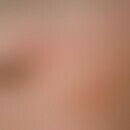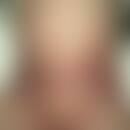Synonym(s)
HistoryThis section has been translated automatically.
DefinitionThis section has been translated automatically.
Rare, congenital, benign Langerhans cell histiocytosis characterized by congenital nodular infiltration of the skin and histopathologic evidence of Langerhans cell infiltrates.
You might also be interested in
ManifestationThis section has been translated automatically.
LocalizationThis section has been translated automatically.
ClinicThis section has been translated automatically.
In about 1/4 of newborns, only a single focus is found, usually a flat, asymptomatic, 0.2-1.0cm reddish plaque or plaque, with the surface usually intact. Ulceration is possible. The general condition of the patient remains undisturbed. The occurrence of multiple lesions is possible. In this constellation (see Fig.), Abt-Letterer-Siwe disease must be included in the differential diagnosis (progression or healing in the first months of life).
HistologyThis section has been translated automatically.
Dense dermal infiltrate of histiocytic cells (immunohistology: CD1a pos./S100 pos.) with irregular, large nuclei and partially foamy cytoplasm. Erythrocyte diapedesis.
Electron microscopy: Histiocytes with lamellar, false and true myelin figure-like inclusions. No Birbeck granules ("tennis rackets").
DiagnosisThis section has been translated automatically.
Histology/electron microscopy are diagnostic.
Differential diagnosisThis section has been translated automatically.
General therapyThis section has been translated automatically.
External therapyThis section has been translated automatically.
Progression/forecastThis section has been translated automatically.
Spontaneous regression within the first years of life. Caution: Initially, differentiation from Abt-Letterer-Siwe disease may be difficult. Here, the clinical course must be awaited.
LiteratureThis section has been translated automatically.
- Brazzola P et al (2003) Congenital self-healing langerhans cell histiocytosis with atrophic recovery of the skin: clinical correlation of an immunologic phenomenon. J Pediatr Hematol Oncol 25: 270-273.
- Hashimoto K, Pritzker MS (1973) Electron microscopic study of reticulohistiocytoma. An unusual case of congenital, self-healing reticulohistiocytosis. Arch Dermatol 107: 263-270
- Inuzuka M et al (2000) Congenital self-healing reticulohistiocytosis presenting with hemorrhagic bullae. J Am Acad Dermatol 48: S75-77.
- Larralde M et al (2003) Congenital self-healing Langerhans cell histiocytosis: the need for a long term follow up. Int J Dermatol 42: 245-246
- Laugier P, Hunziker N et al (1975) Reticulohistiocytosis of benign evolution (Hashimoto-Pritzker type). Electron microscopy study. Ann Dermatol Syphiligr (Paris) 102: 21-31.
Rizzoli A et al (2021) Congenital self-healing reticulohistiocytosis in a newborn: unusual oral and cutaneous manifestations. Ital J Pediatr 47:135.
Incoming links (6)
Clioquinol cream 0.5-2% (o/w); Clioquinol lotio 0.5-5%; Quinolinol sulphate monohydrate solution 0,1 % (nrf 11.127.); Reticulohistiocytosis, congenital, self-healing; Reticulohistiocytosis multicenter; Reticulohistiocytosis(s);Outgoing links (10)
Abt-letterer-siwe disease; Clioquinol; Clioquinol cream 0.5-2% (o/w); Clioquinol lotio 0.5-5%; Hemangiomatosis, neonatal; Histiocytosis benign cephalic; Juvenile xanthogranuloma; Langerhans cell histiocytosis (overview); Polihexanide; Potassium permanganate;Disclaimer
Please ask your physician for a reliable diagnosis. This website is only meant as a reference.











